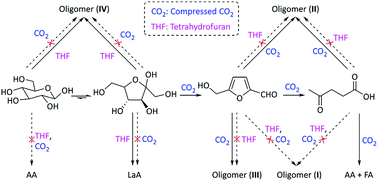Suppression of oligomer formation in glucose dehydration by CO2 and tetrahydrofuran†
Abstract
The transformation of readily available cellulosic biomass to small-molecule products is important in biorefining. To improve the economic viability, the formation of humins should be limited. Herein, we report the effective suppression of humin precursor (i.e., oligomer) formation in glucose-to-5-hydroxymethylfurfural (HMF) dehydration by the synergetic action of tetrahydrofuran (THF) and low-pressure CO2 (1.0 MPa). We show that four kinds of oligomers are formed in water, wherein the cross-condensation of HMF and levulinic acid (LA) generates oligomers (I) and (II), and the self-condensation of HMF generates oligomer (III), while the degradation of glucose/fructose generates oligomer (IV). In CO2-splitted triphasic H2O/THF (VH2O/VTHF = 1 : 1), the formation of oligomers (I) and (IV) is suppressed by CO2, while the formation of oligomers (I), (II), and (III) is inhibited by THF. This work highlights a strategy for increasing carbon utilization from glucose conversion by controlling the subreactions to favor the pathways towards the formation of small-molecule products.



 Please wait while we load your content...
Please wait while we load your content...